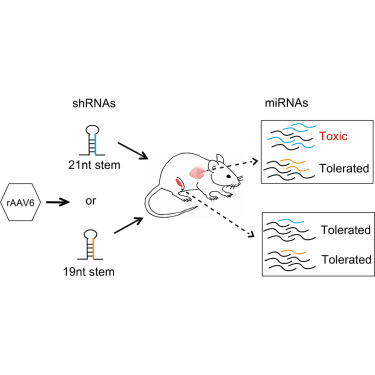Molecular Therapy - Nucleic Acids ( IF 8.8 ) Pub Date : 2019-12-18 , DOI: 10.1016/j.omtn.2019.12.007 Meredith M Course 1 , Kathryn Gudsnuk 1 , Nitin Desai 1 , Joel R Chamberlain 1 , Paul N Valdmanis 1

|
Gene knockdown using short hairpin RNAs (shRNAs) is a promising strategy for targeting dominant mutations; however, delivering too much shRNA can disrupt the processing of endogenous microRNAs (miRNAs) and lead to toxicity. Here, we sought to understand the effect that excessive shRNAs have on muscle miRNAs by treating mice with recombinant adeno-associated viral vectors (rAAVs) that produce shRNAs with 19-nt or 21-nt stem sequences. Small RNA sequencing of their muscle and liver tissues revealed that shRNA expression was highest in the heart, where mice experienced substantial cardiomyopathy when shRNAs accumulated to 51.2% ± 13.7% of total small RNAs. With the same treatment, shRNAs in other muscle tissues reached only 12.1% ± 5.0% of total small RNAs. Regardless of treatment, the predominant heart miRNAs remained relatively stable across samples. Instead, the lower-expressed miR-451, one of the few miRNAs processed independently of Dicer, changed in relation to shRNA level and toxicity. Our data suggest that a protective mechanism exists in cardiac tissue for maintaining the levels of most miRNAs in response to shRNA delivery, in contrast with what has been shown in the liver. Quantifying miRNA profiles after excessive shRNA delivery illuminates the host response to rAAV-shRNA, allowing for safer and more robust therapeutic gene knockdown.
中文翻译:

内源性 MicroRNA 竞争作为 shRNA 诱导的心脏毒性机制。
使用短发夹 RNA (shRNA) 的基因敲除是一种很有前景的靶向显性突变的策略。然而,传递过多的 shRNA 会破坏内源性 microRNA (miRNA) 的加工并导致毒性。在这里,我们试图通过用产生具有 19-nt 或 21-nt 茎序列的 shRNA 的重组腺相关病毒载体 (rAAV) 治疗小鼠来了解过量 shRNA 对肌肉 miRNA 的影响。对其肌肉和肝脏组织的小 RNA 测序显示,shRNA 在心脏中的表达最高,当 shRNA 积累到总小 RNA 的 51.2% ± 13.7% 时,小鼠会出现严重的心肌病。在相同的处理下,其他肌肉组织中的 shRNA 仅达到总小 RNA 的 12.1% ± 5.0%。无论治疗如何,主要的心脏 miRNA 在样本中保持相对稳定。相反,低表达的 miR-451 是少数独立于 Dicer 加工的 miRNA 之一,它与 shRNA 水平和毒性有关。我们的数据表明,心脏组织中存在一种保护机制,用于维持大多数 miRNA 的水平以响应 shRNA 递送,这与肝脏中显示的情况相反。在过量 shRNA 递送后量化 miRNA 谱可以阐明宿主对 rAAV-shRNA 的反应,从而实现更安全、更稳健的治疗基因敲除。我们的数据表明,心脏组织中存在一种保护机制,用于维持大多数 miRNA 的水平以响应 shRNA 递送,这与肝脏中显示的情况相反。在过量 shRNA 递送后量化 miRNA 谱可以阐明宿主对 rAAV-shRNA 的反应,从而实现更安全、更稳健的治疗基因敲除。我们的数据表明,心脏组织中存在一种保护机制,用于维持大多数 miRNA 的水平以响应 shRNA 递送,这与肝脏中显示的情况相反。在过量 shRNA 递送后量化 miRNA 谱可以阐明宿主对 rAAV-shRNA 的反应,从而实现更安全、更稳健的治疗基因敲除。

























 京公网安备 11010802027423号
京公网安备 11010802027423号